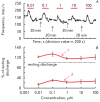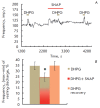Soluble Guanylate Cyclase As the Key Enzyme in the Modulating Effect of NO on Metabotropic Glutamate Receptors
- PMID: 30116618
- PMCID: PMC6087819
Soluble Guanylate Cyclase As the Key Enzyme in the Modulating Effect of NO on Metabotropic Glutamate Receptors
Abstract
The synaptic plasticity of the afferent synapse of the vestibular apparatus is defined by the dynamic interaction of ionotropic and metabotropic glutamate receptors and the modulators of synaptic transmission. It was shown that nitric oxide modulates iGluR responses. In this paper, the effect of NO on the function of the afferent synapse mGluR was investigated. Inhibitor of nitric oxide synthase lowered the level of background activity but increased the amplitude of the responses of groups I and II mGluR agonist ACPD. Donor NO SNAP increased the level of background activity. Short-term perfusion of the synaptic region with low concentrations of SNAP led to a decrease in the amplitude of the answers of mGluR agonists ACPD and DHPG. The inhibitory effect of the NO donor was eliminated under blockade of soluble guanylate cyclase with a specific inhibitor ODQ. A prolonged application of NO did not cause a statistically significant change in the amplitude of the ACPD response. However, SNAP at concentrations of 10 and 100 μM increased the amplitude of the mGluR agonist responses 30 and 15 minutes, respectively, after termination of the NO donor exposure. The obtained data show the multidirectional effect of NO on the function of mGluR and testify to the existence of a complex modulating mechanism of the afferent flow from vestibular organs to the central nervous system.
Keywords: metabotropic glutamate receptors; nitric oxide; soluble guanylate cyclase; synaptic plasticity; vestibular apparatus.
Figures





Similar articles
-
Metabotropic glutamate receptors as targets of neuromodulatory influence of nitric oxide.Dokl Biol Sci. 2016 Jul;469(1):149-51. doi: 10.1134/S0012496616040049. Epub 2016 Sep 7. Dokl Biol Sci. 2016. PMID: 27595818
-
Potentiation of NMDA receptor-mediated transmission in turtle cerebellar granule cells by activation of metabotropic glutamate receptors.J Neurophysiol. 1993 Feb;69(2):585-94. doi: 10.1152/jn.1993.69.2.585. J Neurophysiol. 1993. PMID: 7681476
-
Immunocytochemical and pharmacological characterization of metabotropic glutamate receptors of the vestibular end organs in the frog.Hear Res. 2005 Jun;204(1-2):200-9. doi: 10.1016/j.heares.2005.02.003. Hear Res. 2005. PMID: 15925205
-
Heterologous modulation of inhibitory synaptic transmission by metabotropic glutamate receptors in cultured hippocampal neurons.J Neurophysiol. 1996 Feb;75(2):885-93. doi: 10.1152/jn.1996.75.2.885. J Neurophysiol. 1996. PMID: 8714661
-
Influence of metabotropic glutamate receptor agonists on the inhibitory effects of adenosine A1 receptor activation in the rat hippocampus.Br J Pharmacol. 1997 Aug;121(8):1541-8. doi: 10.1038/sj.bjp.0701291. Br J Pharmacol. 1997. PMID: 9283686 Free PMC article.
Cited by
-
Development of therapeutic supplement using roasted-cashew-nut to protect cerebral vasoconstriction injury triggered by mixture of petroleum hydrocarbons in the hypothalamus and hippocampus of rat model.Toxicol Rep. 2025 Feb 5;14:101943. doi: 10.1016/j.toxrep.2025.101943. eCollection 2025 Jun. Toxicol Rep. 2025. PMID: 39996038 Free PMC article.
References
-
- Flores A., Leyn-Olea M., Vega R., Soto E.. Neurosci. Lett. 1996;205:131–134. - PubMed
-
- Lysakowski A., Singer M.. J. Comp. Neurol. 2000;427:508–521. - PubMed
-
- Takumida M., Anniko M.. In vivo. 2004;18:345–350. - PubMed
-
- Takumida M., Anniko M.. ORL J. Otorhinolaryngol. Relat. Spec. 1998;60:67–72. - PubMed
-
- a. Popa R., Anniko M., Takumida M.. Acta Otolaryngol. 2000;120:350–358. - PubMed
LinkOut - more resources
Full Text Sources
Research Materials
